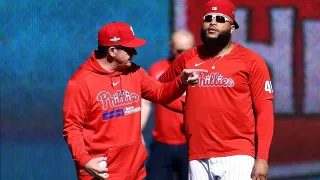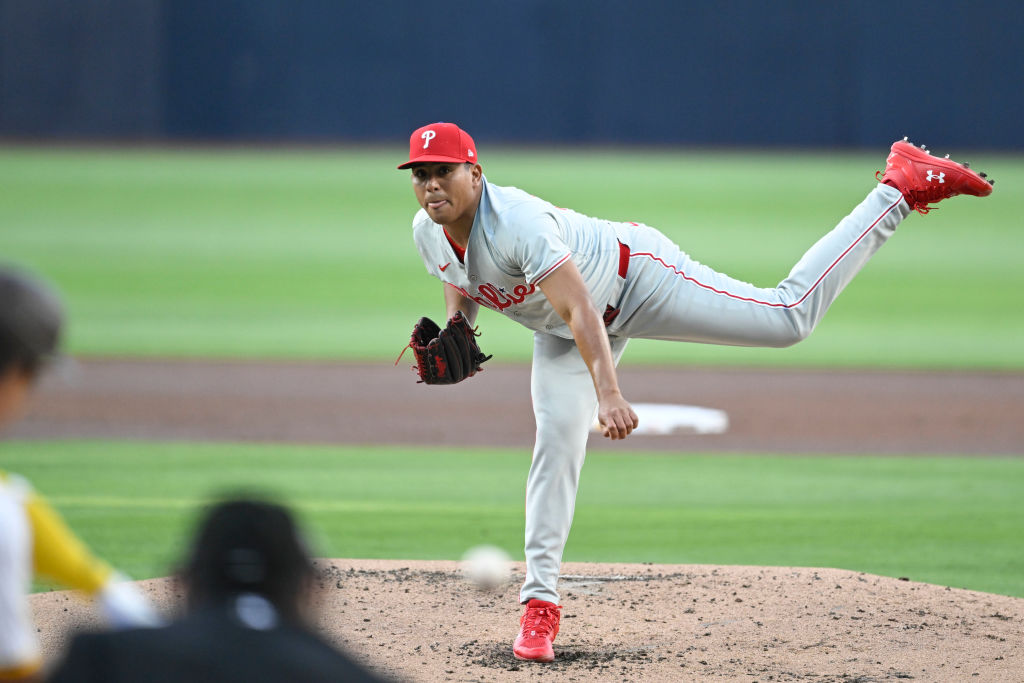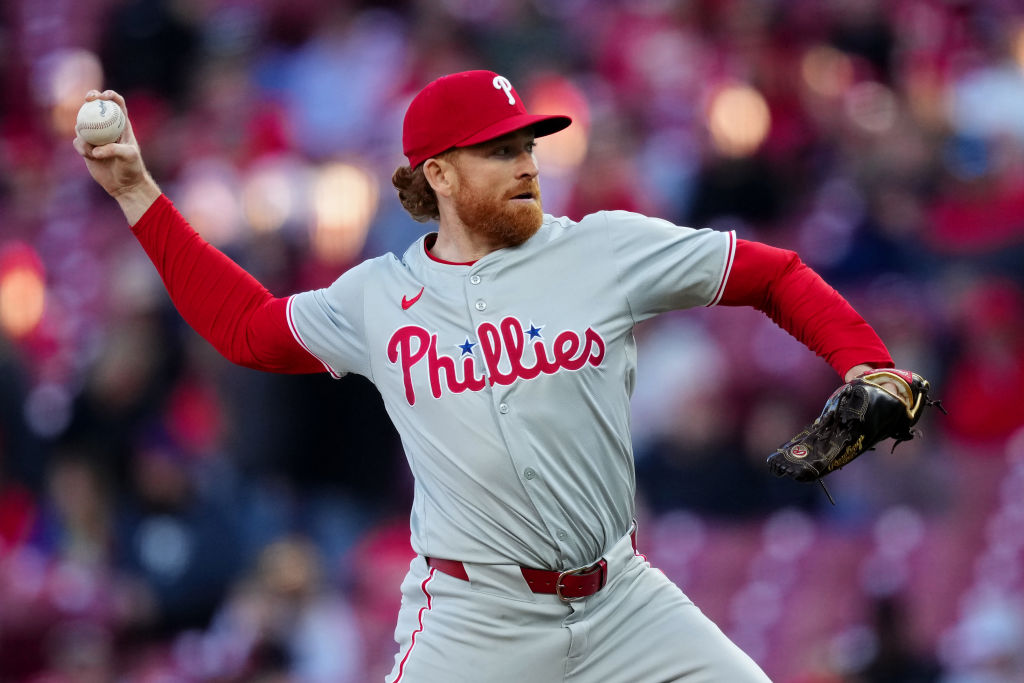
In the days leading up to Phillies Opening Day on March 28, we're taking a daily look at the biggest questions and storylines surrounding the team in 2024.
Among the species listed as endangered by the World Wildlife Fund are the Asian elephant, Amur leopard and black-footed ferret.
In baseball, that category would include the Great American Wipeout Closer.
Stay in the game with the latest updates on your beloved Philadelphia sports teams! Sign up here for our All Access Daily newsletter.
Once again, Phillies manager Rob Thomson has declined to designate the singular reliever who will, with great fanfare, automatically trot out of the bullpen every time his team has a lead to protect in the ninth.
Most of the guessing has centered on Jose Alvarado. Thomson does not confirm or deny. One of his strengths is how nimbly he avoids publicly painting himself into a corner. It could be Alvarado. But on any given night it could also be Jeff Hoffman. Or Serranthony Dominguez. Or Gregory Soto. Or Matt Strahm. Or eventually even just-short-of-23-year-old Orion Kerkering, who rocketed all the way from beginning last season at Class A to a September call-up and a spot on the postseason roster.
Thomson isn't alone, either. The reality is that, when the regular season opens with a 3:05 game against the Braves at Citizens Bank Park next Thursday, the Phillies' approach will be more the rule than the exception.
Not that long ago, the bullpen calculus was pretty simple. Not having a dominant closer equaled the dreaded bullpen-by-committee which in turn equaled a drastically reduced chance of winning. At least, that was the thought process.
Philadelphia Phillies
No more. Of the dozen clubs that qualified for the 2023 postseason, half had a reliever who led the team with 25 or fewer saves. That included Philadelphia, where Craig Kimbrel notched 23 while eight other Phillies relievers had at least one, accounting for 48.9 percent of the total.
How quickly things change.
Francisco Rodriguez saved 62 games for the Angels in 2008. As recently as 2014, just 10 years ago, seven different closers were credited with a minimum of 40.
There have been a TOTAL of seven in the last five full seasons. Last year, Cleveland's Emmanuel Clase (44) stood at the head of a class of one.
"I do believe that the quote-unquote old school managers would prefer to have one guy who they feel can close," Ruben Amaro Jr. told NBC Sports Philadelphia this week. "Part of the issue is that organizations are not conditioning pitchers to be able to do this. There are so many people in the development programs who are not allowing their relievers to pitch back-to-back. So they're not being conditioned to be able to be the guy."
Amaro has studied the game from the perspective of a big league player, coach, assistant general manager (under Ed Wade and Hall of Fame executive Pat Gillick) and general manager. He's now an analyst for Phillies games and pre- and postgame shows on NBC Sports Philadelphia. He's observed this trend. He's dismayed by it. And he has a pretty good idea of why it's happening.
Another factor, he noted, is that almost all pitchers are encouraged to throw every pitch with maximum effort and to spin the ball as hard as possible. As a result, they don't easily recover in time to pitch multiple days in a row.
"And it's a shame because it puts the managers in a tough position," he added. "The availability of their closer is no longer the same as it once was. I'd much rather have one guy try to get three outs every night than two or three different guys. It's just a very difficult task."
The way bullpens are deployed is a direct result of the fact that starters are no longer expected to go seven or eight innings or even — gasp! — pitch a complete game. It's become a reflex reaction to at least think about lifting the starter after he's faced 18 batters because there are stats that indicate many begin to lose effectiveness the third time through the opposing batting order. The expectation for how deep into a game they'll pitch is low. And they meet it.
It doesn't have to be that way. Starters now routinely display their full palette of pitches from the get-go, rather than holding something in reserve for later. Having been mentally calibrated to only having to face each hitter twice, there's little reason to hold back either in terms of repertoire or the physical exertion expended on each pitch.
And, hey, somebody's gotta pitch those innings. Which means more and more arms are needed to cover the increased workload at the back end. "And there's just not enough quality pitching among the 30 teams to do that," Amaro concluded.
Part of this evolution was sparked by the analytics revolution, which posed a logical question. Does it make sense to always reserve your best reliever for the ninth inning? After all, if the game is on the line in, say, the seventh, and the other team is rallying, wouldn't it be better to use your best resources to extinguish the threat? Otherwise, there may be no lead to protect in the ninth.
Mixing and matching in the end stages also gives a manager more flexibility to exploit left-right matchups and roll with the hot hand.
On the other hand, that also contradicts the accepted trope that relievers perform best when they know what their role will be. Not to mention the conventional wisdom that the final three outs of the game are very different from any that come before it, that it takes a certain personality type to get the job done when the outcome hangs in the balance.
The dirty little secret is that Phillies fans usually don't have to hold their breath and wonder who'll emerge when the bullpen gates swing open in the ninth. Without bestowing the title, Thomson is pretty consistent with who he uses in closer situations. At the beginning of last year, it was Alvarado. After he was sidelined by elbow inflammation for most of May and early June, Kimbrel inherited the role for the most part although, when he faltered somewhat in the second half he was used as the set-up reliever a handful of times.
There's one more widely believed assumption that has to be a quiet concern for the Phillies. It goes like this: Relievers tend to be wildly inconsistent from one year to the next. The assumption has always been that this is at least loosely a fallout from being rode hard and put up wet more often when they're doing well. Amaro mentioned former Phillies lefty Rheal Cormier as a classic example. Beginning in 2003 his yearly earned run averages were 1.70, 3.56 (when he was used an astonishing 84 times), 5.89, 2.44 and 1.59.
"It's always a concern for me when a reliever has to log 60 or 70 appearances," he said. "You just don't know, over time, how that pitcher will react."
The Phillies are pretty steadfast about not using relievers three days in a row or three out of four games. The inevitable ripple effect is more pitchers working more innings.
Despite those safeguards, Soto made 69 appearances in 2023. He was followed by Hoffman (63, including nine at Triple-A), Dominguez (59, including two rehab assignments) and Strahm (56, which included 10 starts and bumped his workload to 87.2 innings). Alvarado had "only" 42 but also spent two stints on the injured list.
Amaro suspects that the Tampa Bay Rays started the trend with the success they've had with the unconventional approach of frequently using an "opener" followed by a bulk reliever followed by playing the percentages to close out games. And there's always been a certain amount of groupthink in baseball.
At the same time, this offseason the Astros went dramatically against the tide by signing closer Josh Hader to a five-year, $95 million contract.
When Amaro was general manager, he did the same thing in 2012 by giving Jonathan Papelbon a four-year, $50 million deal. At the time, that was a record for a closer. Even then, some in baseball rolled their eyes. Unfortunately for the Phillies, it didn't work out the way he'd hoped. After five straight trips to the playoffs, they never had a winning record with Papelbon on the roster.
Which doesn't mean it wasn't the correct decision at the moment.
"At that time he was the best guy and really, he ended up pitching to his contract (234 games, 2.31 ERA before being traded to Washington at the 2015 deadline). Unfortunately, the rest of the team around him kind of stunk because we got hurt and we got older and we just weren't as effective," Amaro reflected.
"But I still believe that at the end of the day, it was important for my manager to have somebody he could count on at the back end of the bullpen. (Ryan) Madson was going to be a choice. It ended up not working out as far as the contract situation was concerned. But once that didn't happen, I wanted to get the best guy available. A guy who had done it before. The guy who wants the baseball regardless and had done it in the Northeast, in Boston, a very tough town."
The Phillies have a proud history of closers. Brad Lidge dropping to his knees as Citizens Bank Park exploded in sound in 2008. Tug McGraw dancing an Irish jig after striking out Willie Wilson in 1980 to clinch the first world championship in franchise history. Steve Bedrosian winning the Cy Young Award in 1987. Jim Konstanty being voted Most Valuable Player in 1950. Mitch Williams. Billy Wagner. Jose Mesa. Ricky Bottalico.
"The formula worked," Amaro said. "I just felt that was the way to go because while we had some good quality in that bullpen, we didn't have somebody that I was comfortable getting those three outs every single time."
This season, the Phillies will try to win with a different formula. Lucky for them, that's also worked as well.


